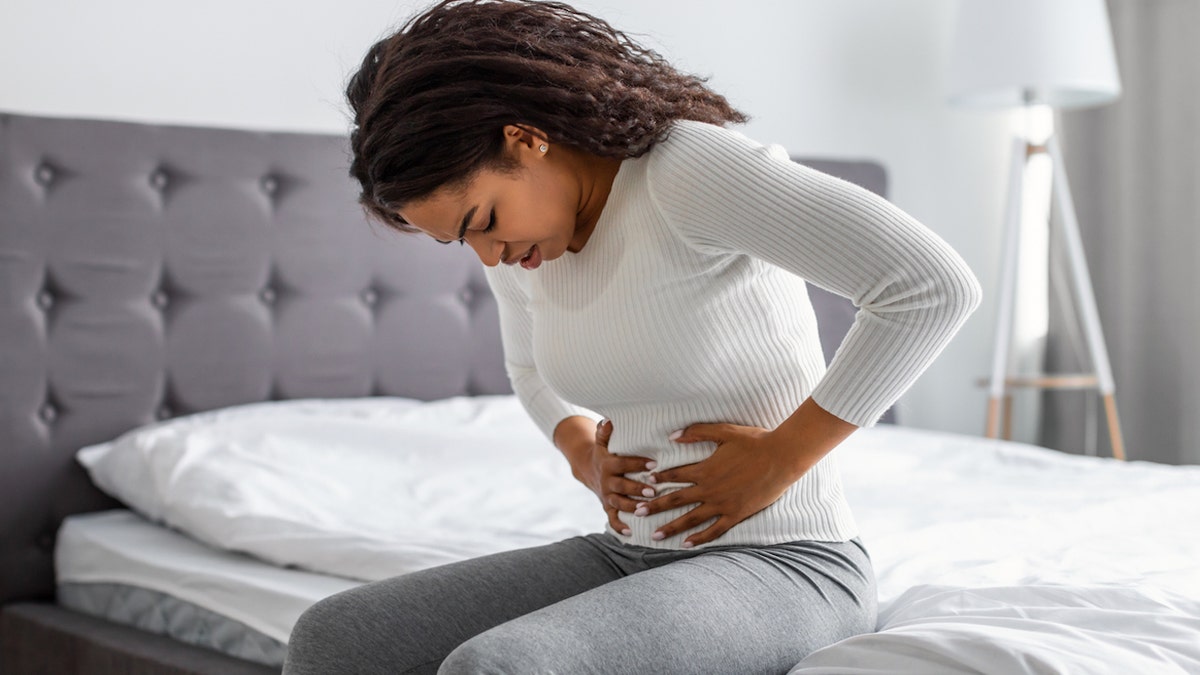Leftover pasta causes food poisoning and kills college student
Student dies after his liver shuts down from eating 5-day-old pasta leftovers
If you eat out at a restaurant or food stand and come down with food poisoning afterward — the food may not be the only thing to blame.
A new report from the Centers for Disease Control and Prevention (CDC) out this week summarized data from 800 outbreaks due to foodborne illnesses at U.S. restaurants in 25 states during the years 2017-2019.
The report found that 40% of foodborne outbreaks with an identifiable cause were associated with sick workers — most often due to a virus known as norovirus.
A bacteria known as salmonella was the second most identifiable cause of the foodborne outbreaks in approximately 19% of the cases, the CDC said.
Norovirus is the most common cause of foodborne illness — yet salmonella leads to more hospitalizations and deaths, according to the CDC.

A woman is shown eating out. A new report from the CDC found that 40% of foodborne outbreaks with an identifiable cause were associated with sick workers — most often due to a virus known as norovirus. (iStock)
Here’s a deeper dive into the condition and when it’s important to see a health care professional.
How the germs or toxins are transmitted
Every year approximately 48 million people get sick from foodborne illnesses, with 128,000 of them hospitalized.
Some 3,000 people die from these diseases, according to the CDC.
Sometimes food that’s not handled properly contains toxins that originate from a variety of sources.
"Certain foods are more likely to cause food poisoning (undercooked poultry and meat, but also sprouts, uncooked flour, raw milk/raw milk cheeses)," Dr. Matthew Weissman, site chair for the department of medicine at Mount Sinai Beth Israel and Mount Sinai Downtown in New York City told Fox News Digital in an email on the topic.
Food poisoning occurs when people get sick after swallowing food or drink that is contaminated with germs or toxins, according to Mount Sinai’s website.

A CDC report out this week summarized data from 800 outbreaks due to foodborne illnesses at U.S. restaurants in 25 states during the years 2017-2019. The report found that 40% of foodborne outbreaks with an identifiable cause were associated with sick workers. (Jeffrey Greenberg/UCG/Universal Images Group via Getty Images)
The germs "can also be transmitted without food [from] person to person if someone hasn't washed their hands after going to the bathroom," Weissman added.
Sometimes food that’s not handled properly contains toxins that originate from a variety of sources, not only from bacteria but also chemicals, heavy metals and even fish, such as shellfish, per a public health report.
WEIGHT LOSS SURGERIES ON THE RISE AMONG KIDS AND TEENS, STUDY FINDS: ‘ALTERING THE ANATOMY’
When food poisoning occurs secondary to a toxin ingestion, the symptoms generally occur quickly within minutes to hours, resulting in sometimes uncontrollable vomiting and/or diarrhea, the report added.
The other way to acquire food poisoning is swallowing food contaminated with bacteria, parasites or viruses.
Antibiotics are not generally helpful in these cases because the underlying cause is the toxin production, which the body is naturally trying to expel.
The other way to acquire food poisoning is swallowing food contaminated with bacteria, parasites or viruses.
These symptoms take a longer time to develop compared to toxins — and are more easily transmitted person-to-person.
"Both bacteria (like salmonella, E. coli, listeria, Staph aureus) and viruses (including norovirus and hepatitis A) are very common causes of food poisoning," Weissman noted.
"Some parasites like giardia and cryptosporidium can also cause food poisoning," he said.

The exact symptoms of food poisoning depend on the germ that the person swallows, so the symptoms can range from mild to serious, lasting for a few hours to several days. (iStock)
"There have recently been some multistate outbreaks [due to] salmonella and [hepatitis] A in food."
He said antibiotics depend on what is causing the food poisoning and reminded they won't help viruses.
What are the symptoms?
The exact symptoms depend on the germ that the person swallows, so the symptoms can range from mild to serious, lasting for a few hours to several days.
The most common symptoms of food poisoning are gastrointestinal related, including diarrhea, stomach pain, nausea, vomiting and sometimes fever.
Food poisoning due to a viral cause often results in watery diarrhea, whereas a bacterial cause often causes diarrhea with mucus and blood.
The most common symptoms of food poisoning are gastrointestinal related, including diarrhea, stomach pain, nausea, vomiting and sometimes fever.
Norovirus
Norovirus classically causes vomiting and diarrhea but can cause also cause stomach pain in what is often known as the "stomach flu" — but is not related to the flu, per the CDC.
People usually get sick within 12-48 hours after being exposed to contaminated water or food, such as leafy greens, fresh fruits and raw oysters.
TENNESSEE MAN EATS ONLY MCDONALD'S FOOD FOR 100 DAYS STRAIGHT: HERE'S WHAT HAPPENED
Norovirus can also spread on contaminated surfaces, Weissman added.
Most people get better on their own within one to three days, although they can still spread the virus for a few days after their syndrome is resolved, according to the CDC.
Salmonella
People who are infected with salmonella classically experience diarrhea that sometimes is bloody. They can also complain of a fever and stomach cramps as well as nausea, vomiting or a headache, per the CDC.
The symptoms can start as soon as six hours to six days after ingesting the bacteria; they usually resolve within one week.
People are more susceptible to the infection if they eat raw or undercooked chicken, undercooked eggs, unpasteurized raw milk, raw fruits or vegetables.
Although salmonella is a bacterial infection, most cases get better on their own without antibiotics.
"In some cases, antibiotics can do more harm than good — for example, in some cases of salmonella, it can increase the time that you carry the bacteria," Weissman said.

One health professional recommends seeing a doctor if there's a change in mental status or there's severe pain — but "in children/infants, my threshold for calling the doctor would be even lower," he told Fox News Digital. (iStock)
Being a healthy carrier means the bacteria is inside the patient’s body, but the person does not have any signs or symptoms of disease.
A famous example of this is Mary Mallon, who was the first known healthy carrier of the Salmonella bacteria in the U. S., according to the National Institutes of Health.
She spread Salmonella typhi among the wealthy families she worked for as a cook and is said to be responsible for several outbreaks, with the public stigmatizing her as "Typhoid Mary."
She died in 1938 after she was quarantined for more than 20 years on North Brother Island in New York, where people with communicable diseases were isolated from the public.
When to see a doctor
Make an appointment to see a doctor if you develop bloody diarrhea, start vomiting to the point where you can’t keep liquids down, have a fever higher than 102°F, or continue to have diarrhea for more than three days, the CDC recommends.
"Handwashing with soap and water for 10-20 seconds especially after using the bathroom and before eating is really important."
The agency also recommends watching for signs of dehydration, which include not urinating as much as usual, a dry mouth and feeling dizzy when standing up.
Dr. Weissman of Mount Sinai recommends seeing a provider if there's a change in mental status or there's severe pain — but "in children/infants, my threshold for calling the doctor would be even lower."
CLICK HERE TO SIGN UP FOR OUR LIFESTYLE NEWSLETTER
He recommends rehydrating with oral rehydration solutions or sports drinks but cautions that people may experience vomiting if they drink too much in a short span of time — so people should rehydrate slowly, taking in a teaspoon of liquid every few minutes.
"Wash hands regularly — hand sanitizer isn't very good at killing norovirus or a common stool infection called C. diff (Clostridioides difficile), so handwashing with soap and water for 10-20 seconds especially after using the bathroom and before eating is really important," he added.
The doctor also noted there's a vaccine for hepatitis A that's available.
CLICK HERE TO GET THE FOX NEWS APP
"It's now given regularly to children since the late 1990s or early 2000s (depending on the state), so people born before that time may want to get vaccinated to help prevent hepatitis A."









































